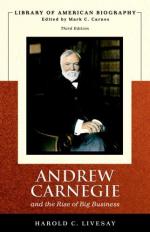
|
| Name: _________________________ | Period: ___________________ |
This test consists of 5 multiple choice questions, 5 short answer questions, and 10 short essay questions.
Multiple Choice Questions
1. Carnegie, acting under Scott-Thomson proxies, now owns how much of Pacific and Atlantic for the start-up Keystone Telegraph?
(a) One fourth.
(b) One third.
(c) One eighth.
(d) One half.
2. Who is the cornerstone of Carnegie's fortune, followed in 1861 by Columbia Oil?
(a) Pennsylvania Railroad.
(b) Woodruff.
(c) Coleman.
(d) Pullman.
3. How many people immigrate from the Old to the New World to embed the dream into an image of America far stronger than the success of a few like the Guggenheims and Vanderbilts?
(a) Tens of millions.
(b) Tens of thousands.
(c) Tens of billions.
(d) Hundreds.
4. In 1856, Scott advises him to buy what company as his first stock investment?
(a) Amos Express Company.
(b) Adams Express Company.
(c) Anthony Express Company.
(d) Aaron Express Company.
5. Who was the founder of Intel and Liz Claibourne?
(a) Hungarian Andy Grove.
(b) American Cuba Gooding, Jr.
(c) Indian Pooja Patel.
(d) Cuban Roberto Goizuetta.
Short Answer Questions
1. Erie and Pennsylvania Railroads each have ________ thousand employees trained into a disciplined workforce.
2. When dividend payments stop, Carnegie plans a ________ exit to maximize Pacific's price by speculation that lets the triumvirate cash out and leave the remaining Pacific stockholders to drown.
3. Andrew's opportunity to escape the coal and oil of textile mills comes through _________ asking him to become a messenger boy with a telegraph company in Pittsburgh.
4. Carnegie uses a similar strategy to exit the Woodruff Company by reorganizing it into ________________ with new stockholders and the triumvirate unstated.
5. Will is unable to catch on to new opportunities and reverts back to weaving and selling his wares on the street, which does what?
Short Essay Questions
1. Why do the Carnegies leave Scotland?
2. Give an example of when Carnegie meets railroad's customers and initiates control of division operations when needed.
3. Describe Carnegie's investment in Keystone Bridge Company.
4. By what is this dream not diminished?
5. What does Daniel McCallum offer those in management?
6. What are the jobs of the railroad managers?
7. What agreement is made between the triumvirate and James L. Shaw?
8. Who is George M. Pullman? How do he and Carnegie become involved in business together?
9. The partners pledge an investment to be made in installments paid when due or by the company as credit for dividends payable on the whole investment. Give an example of this pledge in action.
10. How do family members and friends help immigrants? How is Carnegie's family helped?
|
This section contains 1,041 words (approx. 4 pages at 300 words per page) |

|




